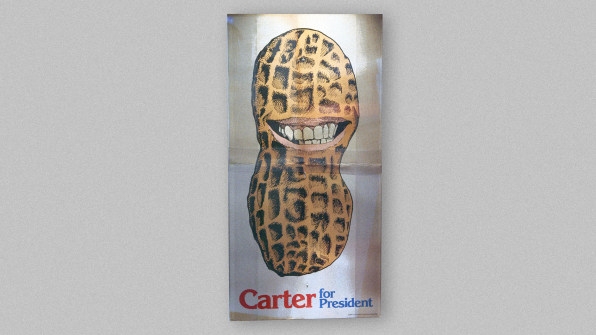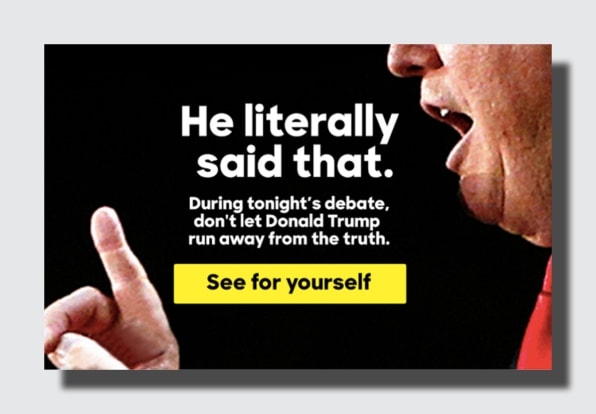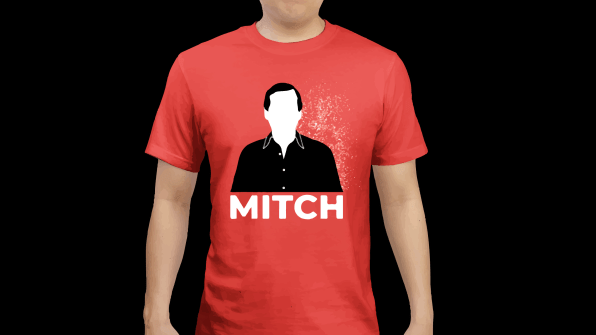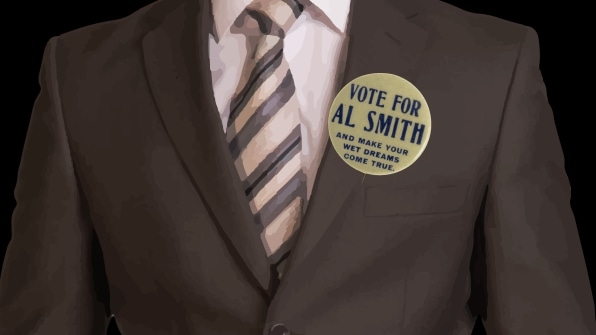“Keep America Great”: It’s the slogan for Trump’s 2020 reelection campaign. It’s also the domain name for a website the Biden campaign nabbed and rebranded with Trump’s policy failings.
The website rewrites Trump’s campaign tag line “Promises Made, Promises Kept” as “Promises Made, Promises Broken.” Stark black-and-white visuals set the backdrop for a laundry list of Trump’s failures. And the logo features an off-kilter “T,” the mark of a man who has fallen irreparably from grace.
The website might seem like an unusual move for Biden, who has positioned himself as a dignified counterpoint to Trump’s relentless trolling and whose visual brand is designed to convey a sense of hope, optimism, and unity. But opposition branding, in which politicians either appropriate an opponent’s visual identity or place the opposition’s messaging in a new visual context, is a longstanding American tradition.
Susan Merriam, cofounder of the Center for American Politics and Design, hypothesizes that this is in part because the United States has a two-party political system, which lends itself to direct, pointed responses from opposing parties—something that has only grown more pronounced in recent years. “As our country has become increasingly bipartisan, and our presidential candidates are further entrenched in their respective parties today, there’s less incentive to appear cordial to their opponents and therefore in turn politicians espouse more outrageous attacks,” Merriam says.
Opposition branding also allows a campaign to dispute an opponent’s claims without having to dignify them. “Vice President Biden parodying the president’s rhetoric or visuals diminishes the power of those statements without having to argue against them, therefore giving them less value,” Merriam says. “It’s a necessary tool for the Biden campaign to combat constant messaging bombardment [from the Trump campaign], which they will probably continue to receive to election day and beyond.”
Politicians of yore had their own reasons for embracing opposition branding. Here, Merriam shares a few examples of politicians’ trolling tête-à-têtes over the decades, from buttons to T-shirts to websites.
#ElectionCollection: Goldwater vs LBJ. Memorable counter from the Democrats during the 1964 presidential campaign. pic.twitter.com/gvUs7YVV0U
— LBJ Library (@LBJLibrary) September 13, 2016
Buttons were the original Twitter dunk
Before there were Twitter dunks, there was the humble button. Long-shot 1964 Republican candidate Barry Goldwater’s campaign released buttons with his profile and the slogan: “In Your Heart You Know He’s Right.”
The slogan “isn’t based on any factual information, so it’s much easier to parody or comment on,” says Merriam. You can prod at the empty meaning of the phrase rather than specific policy. And the Lyndon B. Johnson campaign did exactly that, responding with a button of its own, but with Goldwater’s face in the other direction, and printed in red instead of blue. In a similar all-cap sans serif type, it read: “In Your Guts, You Know He’s Nuts.” Turns out the electorate more or less agreed, and LBJ won reelection.

Fighting over peanuts
In a rather atypical political branding move, 1976 presidential candidate Jimmy Carter made peanuts a major part of his campaign brand. Carter was a former peanut farmer, after all, and it conveyed a stark contrast with Republican incumbent Gerald Ford, who took office after Richard Nixon resigned. Peanut illustrations appeared all over copy and merchandise (“Not just peanuts” was one slogan). But the peanut visuals were also ripe for rebuttal: In response to Carter for President pins such as the one above, featuring a smiling peanut, the Ford campaign used peanuts to their own end and released pins of an elephant crushing the legume, along with the phrase “Don’t settle for peanuts.”

Opposition website 1.0
In 2016, the Hillary Clinton campaign tried its hand at opposition branding with a series of websites, including Trump Yourself, which used Trump’s words against him by placing them alongside a fluorescent yellow and high-contrast black and using unflattering images of Trump. It also turned some insulting quotes into photo filters to make them more personal and immediate—and to show just how wrong he is. Smartly, the Clinton campaign turned Trump’s insult—that Clinton used “the woman card”—into a fundraising opportunity by branding his original quote with the campaign’s typeface, putting it on a literal card tied to donations. The campaign coopted it and made it a positive.

Swamp merchandise
It’s hard to believe this is real, but mudslinging reached a new low when Senator Mitch McConnell’s campaign sold branded T-shirts that referred to an opponent calling him “Cocaine Mitch.” His team made the name its own by putting a graphic likeness of Mitch McConnell on the front of the T-shirt, next to what you can only assume is a flurry of cocaine that someone sneezed on, sending it into the air like free-floating pollen. The back says “Cartel Member,” because nothing says upstanding representative of the people better than glorifying illicit activities.
By silencing Elizabeth Warren, the GOP gave women around the world a rallying cry. #ShePersisted #LetLizSpeak pic.twitter.com/uH6WIngHaL
— Kamala Harris (@KamalaHarris) February 8, 2017
“Nevertheless, she persisted”
In a more positive example, Senator Elizabeth Warren took on a phrase from Senate majority leader Mitch McConnell in 2017, when she gave a floor speech against the nomination of Jeff Sessions as attorney general. McConnell shut it down using a lesser-known House rule, saying “[Warren] was warned. She was given an explanation. Nevertheless, she persisted.” The phrase became a rallying cry and a meme that was turned into a bona fide brand of the Warren campaign, complete with T-shirts, mugs, and even onesies for “pint-sized persisters.”

A platform for wet dreams
This button points to how opposition branding can be a kind of brand extension, allowing supporters who aren’t affiliated with the official campaign to say something a candidate can’t. Democratic New York Governor Al Smith was a Wet (or anti-Prohibition) presidential candidate in 1928. The opposition accused him of drunkenness, and his supporters went below the belt to turn the accusation around in Smith’s favor. The slogan isn’t exactly NSFW, but it is salacious: “Vote for Al Smith and Make Your Wet Dreams Come True.” And yes, “wet dreams” did mean the same thing in 1928.
Fast Company , Read Full Story
(53)